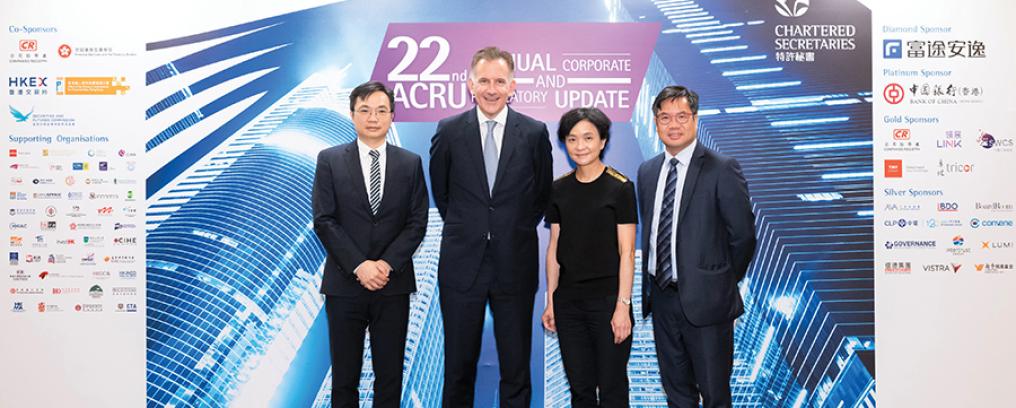CSj completes its review of the latest consultation published by Hong Kong Exchanges and Clearing Ltd in April this year and the views expressed by The Hong Kong Institute of Chartered Secretaries in its submission to the consultation.
Last month’s
CSj looked at the proposals of the latest HKEX consultation regarding organisational culture and board independence. This month, we turn our attention to the remaining proposals of the consultation and the views of The Hong Kong Institute of Chartered Secretaries (the Institute) in its submission to the consultation published last month.
Board diversity
Since January 2019, all listed companies are required to have and disclose a board diversity policy. IPO applicants are required to disclose their board diversity policy in their prospectus and those with a single gender board are further required to explain the measures in place to achieve gender diversity of the board after listing. The Institute’s submission responds to four proposals put forward by the latest HKEX consultation to further promote gender diversity.
1. Single gender boards
The consultation proposes to create new Mandatory Disclosure Requirements (MDRs) to make it clear that a single gender board is not considered a diverse board. The Institute’s submission warns that the wording of the new MDRs would need to be carefully considered to avoid giving the impression that achieving diversity is possible by appointing a single ‘director of the absent gender’ (that is, a female director since there are no all-female boards). ‘It could serve to promote the “one and done” phenomenon that has been observed in other jurisdictions,’ the submission states.
Needless to say, having one female director falls short of promoting the level of diversity required to give rise to an effective board. Moreover, potential female appointees are generally reluctant to join boards without a meaningful representation of women, or a clear commitment to achieve that within a near timeframe, the submission says. Boards with only one female director therefore may well find it difficult to achieve gender diversity due to the understandable perception among potential female appointees that ‘any invitation to serve on the board amounts only to “tokenism” and that the culture of the board will not be welcoming or conducive to the expression of a diverse voice,’ the submission adds.
A report published by the Institute in February this year – Missing Opportunities? A Review of Gender Diversity on Hong Kong Boards (the Review) – calls for a 30% voluntary target for women on boards, with a six-year transition period subject to a ‘comply or explain’ regime, both during and after the transition period. Issuers that do not comply could be obliged to disclose the specific reasons for this and the steps they intend to take to achieve compliance. The Institute’s submission recommends the adoption of such a target in the Corporate Governance Code (the Code), and that the Review should therefore be taken to be incorporated into and form part of the Institute’s current submission.
2. Numerical targets and timelines
The consultation proposes to require all listed companies to set and disclose numerical targets and timelines for achieving gender diversity at both board level and across the workforce, including senior management. The Institute welcomes this proposal, but its submission points out that, beyond the aspirational statements under the Consultation Paper, there are no clear requirements, or even guidance, as to either the targeted level of diversity or the time in which that is to be achieved. ‘As framed, a target of a single female appointment over an extended period of time would meet the MDR. Nor would there be any consequence for non-compliance,’ the submission says.
The submission also questions whether disclosure of gender diversity across the workforce as a whole will be meaningful or insightful unless accompanied by a detailed breakdown of gender across pay grades, occupations, workplaces and staff grades. ‘We tend, therefore, to think that meaningful gender diversity targets and achievements at a leadership level are more important and will lead to a better gender balance across companies as a whole,’ the submission states.
3. Annual review of diversity policies
The consultation proposes to create a new Code Provision requiring boards to review the progress of their diversity policies annually. The Institute’s submission warns that this proposal will be of limited value unless there is also disclosure of the outcome of the board reviews, including the reasons for any failures and measures to correct them. Moreover, the requirement is only likely to be effective where the diversity policy in question is specific, substantive and promotes meaningful diversity and where the review is undertaken by a board which itself is diverse or on a clear pathway to diversity.
4. Gender diversity information disclosure
The consultation proposes to amend relevant forms to require directors to provide gender diversity information upon appointment. HKEX plans to display board diversity–related information (including directors’ age, gender and directorships) on its website. The Institute agrees with this proposal. Its consultation submission points out that disclosure of directors’ gender information will be good for statistical purposes. Nevertheless, the submission warns that there could be sensitivities involved. For example, would transgender persons be allowed to claim the gender they prefer? The Institute suggests
HKEX consults with the Equal Opportunities Commission prior to finalising any proposal.
Nomination committees
The HKEX consultation proposes to upgrade an existing Code Provision to a Listing Rule requiring issuers to have a nomination committee chaired by an independent non-executive director (INED) and comprising a majority of INEDs. Given the importance of the work of nomination committees, the new Listing Rule will be in the interests of good governance, the Institute submits. The Institute also welcomes the HKEX commitment to provide guidance in this area.
Shareholder/stakeholder engagement
To emphasise the importance of establishing a two-way communication between companies and their stakeholders, the HKEX consultation proposes to upgrade current Code Provision E.1.4. to a new Paragraph L of the Code’s MDRs requiring disclosure of the company’s shareholder communication policy. The policy should include disclosure of the channels available to shareholders to communicate their views on various matters affecting the company, as well as disclosure of the steps taken to solicit and understand the views of shareholders and stakeholders. Companies would also be required to review the effectiveness of this policy on an annual basis. The Institute agrees with these proposals but flags up the need to consider the terminology used. For example, since shareholders are a subset of stakeholders – should the reference be to a ‘shareholder and stakeholder communication policy’?
ESG
The HKEX consultation seeks to give greater prominence to the linkage between the management of material environmental, social and governance (ESG) risks (including climate-related risks) and good governance. It proposes to:
- set out the relationship between corporate governance and ESG in the introductory section of the Code, and
- include ESG risks in the context of risk management under the Code.
Furthermore, the consultation proposes to revise the Listing Rules and the ESG Reporting Guide to require publication of ESG reports at the same time as annual reports (see ‘Implementation timeline’ below for the proposed effective dates of this requirement).
The Institute agrees with these proposals. The Institute has, in earlier submissions, noted that the ESG Reporting Guide is more about the ‘ES’ than the ‘G’ part of the formula – governance is covered under the Code. The current submission welcomes the move to give greater clarity regarding the relationship between governance and environmental and social performance and reporting.
Revising the Code’s structure and existing guidance
The consultation also proposes to rearrange the structure of the Code to enhance its flow and readability. It proposes to rename the Code as the ‘Corporate Governance Code’ (currently its full official name is ‘Corporate Governance Code and Corporate Governance Report’), and to move the MDRs (previously set out in the Corporate Governance Report section of the Code) upfront.
HKEX also intends to revise its existing guidance on companies’ compliance with the governance requirements of the Code. It will prepare a new guidance letter (CG GL) that will consolidate additional guidance on the various topics addressed by the consultation together with existing guidance. ‘The new CG GL is intended to stimulate the board’s thinking on how they can carry out their role most effectively, including how the Principles in the Code are applied and reported on. It should be read alongside the rearranged Corporate Governance Code,’ the consultation states.
The Institute agrees with these proposals and points out that more is not necessarily better when it comes to corporate governance requirements. ‘The trend towards more and more Code Provisions, covering more and more issues, runs counter to a basic principle of good corporate governance practice, which is that one size does not fit all’, the submission states.
It adds that in practice most listed companies opt to comply rather than explain any divergence from the Code. This may indicate an element of box-ticking and risks resulting in shareholders and other stakeholders being unable to make informed judgements about the quality of an issuer’s corporate governance, still less how it compares to that of its peers.
The Institute suggests that in future Code revisions, HKEX should give thought to removing provisions that are either not working or unnecessary. Moreover, there should be a greater focus on monitoring the quality of disclosure as opposed to mandating its scope, with the focus being on whether such disclosure is true, meaningful or valuable, and whether it corresponds to what the issuer actually does and which is good for the company and its stakeholders.
Implementation timeline
HKEX intends to implement the revisions to the Code and Listing Rules for financial years commencing on or after 1 January 2022. Extensions to this deadline, however, are proposed in three areas.
1. ESG reporting deadlines. As mentioned above, the consultation proposes to require publication of listed company ESG reports at the same time as annual reports. The implementation date, however, will depend on the commencement date of the issuer’s reporting period. Where the reporting period commences on a day prior to 1 January 2022, the proposed amendment does not apply. Where the reporting period commences on or after 1 January 2022 (for example, 1 January 2022 or 1 April 2022), listed companies would need to publish the ESG reports at the same time as their annual reports.
2. Long-Serving INEDs. In respect of the proposals on Long-Serving INEDs (reviewed in last month’s
CSj), the proposed requirements would be effective for financial years commencing on or after
1 January 2023.
3. Gender diversity. In respect of the proposals on board gender diversity, existing issuers with single gender boards will be allowed a three-year transition period to appoint at least one director of the absent gender on their boards. IPO applicants are not expected to have single gender boards.
The Consultation Paper – Review of Corporate Governance Code and Related Listing Rules – is available on the HKEX website: www.hkex.com.hk. The Institute’s submission to the consultation is available on the Institute’s website: www.hkics.org.hk.


